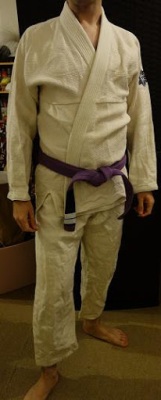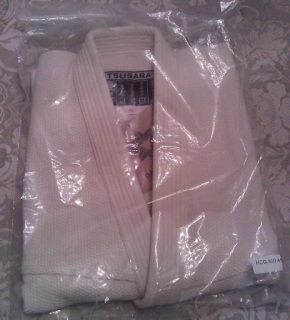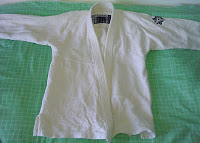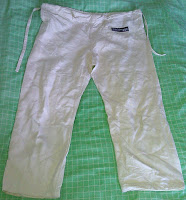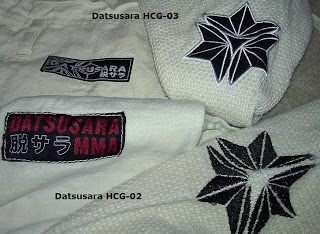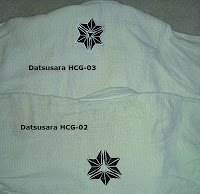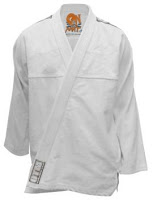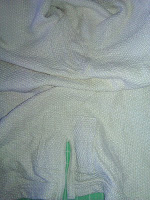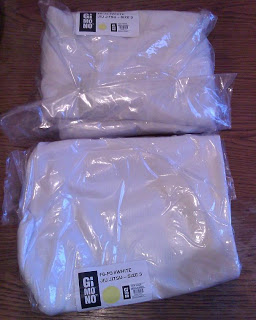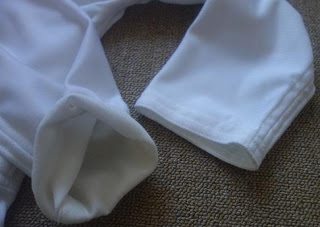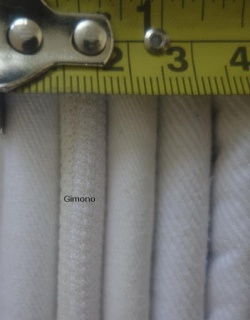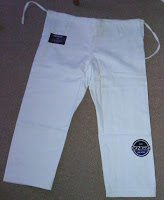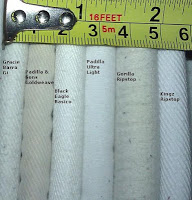Gi Review – Datsusara Hemp Gi (HCG-03)
Posted: 15/12/2012 Filed under: Datsusara, gi review, hemp, non-standard gi material, review Leave a commentShort Review: Datsusara’s follow up to the HCG-02 has a new cut, much better fitting than the old judo-style baggy jacket. As before, the 100% hemp material feels soft and comfortable, while also staying cool due to its porous nature. The stitching issues have also been resolved, aside from one small defect on the belt loop which is probably specific to the particular gi I received. The main drawback is that the HCG-03 has increased in price, meaning that cost is becoming an even more significant obstacle. Available to buy here for $199.95, in either unbleached ‘natural’ white or midnight blue.
Full Review: When I reviewed the HCG-02 for Meerkatsu last year, there were two major flaws that needed to be resolved with the next edition: poor stitching and an overly baggy cut. I was therefore keeping a close eye on those two potential problems after receiving the HCG-03 while I was in Texas. Georgette kindly let me have the gi sent to her home, in addition to all her awesome hospitality while I was there in November. Incidentally, she also has an HCG-03 to review: I’ll update this with a link when it’s up.
The new Datsusara hemp gi comes in either white or midnight blue (no black in this batch). As before, the ‘white’ gi isn’t truly white, but unbleached, resulting in a beige hue. The price has increased by $60: hopefully it won’t rise any higher, but then Odell did say previously that the price was already being kept artificially low while they ironed out any errors. That cost barrier could cause problems, as with the even more unique (and even more expensive) Gimono.
Chris Odell’s explanation is reasonable, but most people will still baulk at the price. If the claim that hemp is so much stronger and more durable than cotton is true, then as with the Gimono, the expense can be justified to an extent:
On the pricing once again guys hemp is so much better than cotton, but you kind of have to use it to really understand. All I can tell you for sure is we pay 4X what other guys pay for just about any gi on the market so as you can see our markup is actually very low considering.
There have been multiple improvements to this updated edition since the HCG-02, while retaining the previous benefits. As I discussed at length in the HCG-02 review, there are many claims regarding hemp. The relevant advantages touted for a hemp gi are:
– Four times stronger than cotton
– Anti-microbial, so allegedly bacteria, mold and fungi can’t live in the gi
– Green: readily renewable and the cultivation process uses limited water
– Porous: breathes well and dries faster
– Wears in rather than wears out
I can’t vouch for it being anti-microbial without access to a laboratory and a science degree, but the HCG-03 still has the wonderful softness of the HCG-02 (and thanks to Georgette’s washing protocol smells fantastic, but that only applies if you’ve washed your clothes in Georgette’s house ;D). It also dries relatively fast, taking about a day, though that is still much longer than either my Gimono or my Gorilla ripstop, both of which dry in a few hours.
Importantly, the HCG-02 issues with stitching have been addressed in the HCG-03. I only noticed a couple of slightly loose threads around the sleeve cuffs, but that was trivial, especially compared to the large gaps on the HCG-02. Having said that, I was surprised that one of the belt loops broke after the second wash. I would guess that is simply a defect in the particular trousers I had, rather than something endemic across all the HCG-03 gis. It isn’t hard to fix, but annoying nonetheless.
An issue that has carried over from the HCG-02 is the amount of lint. I had a pair of black trousers in the same bag as my Datsusara hemp gi, as the temperature in Houston tends to bounce from hot to cold. When I took the black trousers out, they looked like they had been rolled in flour due to all the shedding from my HCG-03. Similarly, in the shower after training it felt like I was using one of those exfoliating shower gels due to all the lint from inside the gi. The HCG-02 stopped shedding after a few washes, so I would assume the same is true with the HCG-03 (other reviews I’ve read mentioned it stopped after four or five washes).
The jacket is 580gsm, while the trousers are 370gsm: that hasn’t changed since the HCG-02, which itself was only slightly lighter than the 600gsm CG-01 hemp/cotton blend. I am used to much thinner jackets, especially as I was testing my Gimono alongside the Datsusara in Texas, but the breathability of the hemp means that it doesn’t feel as heavy as the gsm might indicate. The weave isn’t typical either, as it is a ‘basket weave’ rather than the more common pearl, single and double weaves. It will get creased, unlike the Gimono, but not to the extent of something like the Gorilla. That’s a very minor point though, which I only noticed because the Gimono has such a ridiculously crease-proof drape.
Behind your neck, the inner label of the HCG-03 has increased considerably in size and was slightly itchy at first, though it seems to have lessened with repeated washes. Unlike the HCG-02, the trousers do not come with the option of both a rope and drawstring (or at least mine didn’t). You’re stuck with the flat drawstring, which is fine with me as that’s what I prefer anyway, but I’m aware that many BJJers favour a rope. The thread in the gi is made of nylon, as Odell stated here.
I loved the plain styling of the HCG-02, which has been kept for the HCG-03. The embroidery of the hemp seed ‘mon’ logo has been exchanged for appliqué. This looks much sharper than the old embroidery, with a white border trim. If you want a completely plain gi, I would expect appliqué to be harder to remove than a patch (unlike patches and embroidery, I haven’t tried removing appliqué), but then there are only two of them.
On the back, the Datusara logo has been moved up higher, between the shoulder blades. That shows Datsusara once again listening to criticism, as a number of people disliked the way the HCG-02 back design was in the same spot where you would normally put a team patch. As with the sleeve, this is also appliqué rather than the old embroidery, meaning there isn’t that weird effect from the HCG-02 of a ghostly white version on the inside of the gi. Then again, it would be covered up by the larger inner label anyway with the new HCG-03 design.
A more significant change is the cut. The HCG-02 felt baggy, like a judogi. The HCG-03 is tapered to the body for a far slimmer fit than the old version, in my case further helped by the fact I went with an A1 this time rather than an A2 (though it is still baggy compared to my best-fitting gis, which are probably the Black Eagle Predator and Basico). That improvement in terms of fit is due to the help from Scotty Nelson at OnTheMat, who was a groundbreaking figure in both US BJJ and US-based gi design (he mentions his involvement with Datsusara briefly during his Open Mat Radio interview from a few months ago). The cut of the HCG-03 was taken directly from the OTM 420, though Odell noted in his email to me that the HCG-04 would be changing its cut slightly. Nelson also helped in locating a different manufacturer for the HCG-03. I can’t think of any other pair of gi companies who have been willing to work that closely, so its another refreshing development from Datsusara (and indeed OnTheMat).
There was a great deal of shrinkage with Datsuara’s previous hemp gi, though as Seymour washed the HCG-02 before I got to it, I didn’t see the process. However, he did let me know the stats, which meant that effectively the A2 shrunk down almost to an A1. This time, I got an A1 in the HCG-03 and shrinkage has been far less. I did two washes at Georgette’s house at 25 degrees celsius then hung it up on a door, followed by a third wash at 30 degrees celsius in Bristol. The cuff-to-cuff wingspan started at 159cm, dropping to 155cm, then stabilising at 154cm. Shoulder to hem was originally 80cm, then shrunk to 77cm, where it stayed. Finally, the trousers began at 96.7cm, then steadily shrunk by increments for the first two washes: after the first wash it was 95.5cm, then 94cm. It remained at 94cm with the third wash.
The reinforcements look sufficiently beefy, also made of hemp. There is a large pearl-shaped section on the armpit and a square on the side vent (rather than the triangle used by some other gi companies). The trousers have a long section of additional fabric starting above the knee and stretching all the way to the bottom of the trouser cuff. That prevents the problem of the reinforced section being too low or too high when you kneel on the mat.
The Datsusara HCG-03 is apparently IBJJF legal, as people have mentioned they have won IBJJF competitions while wearing a Datsusara HCG-03. According to the Datsusara website, that is true for both the unbleached white and the midnight blue. Like last time, Odell has been engaging with his customers on various forums, perhaps most notably Sherdog, which is among the largest. For example, he immediately resolved customer complaints regarding defects on this thread, which as a result turned into positive feedback.
The development of new materials and weaves for use in gi construction has notably increased over the last couple of years. Datsusara was and still is a pioneer in the use of hemp: other companies have started to pick up on that, but as yet Datsusara remains the only one to successfully produce a 100% hemp gi. With bamboo, ripstop, hemp blends and unusual combinations like Gimono’s ‘Fortitude’ fabric, I hope that innovation will continue in the gi world, rather than just different colour and patch combinations.
The Datsusara HCG-03 is available to buy here for $199.95, in either unbleached ‘natural’ white or midnight blue, although many sizes are now sold out. It is worth noting that Odell told me yet another version of the Datsusara hemp gi is due for release, with the HCG-04 expected to land around March 2013. I’ll be interested to see if there are many further changes for the HCG-04. It would appear that most of the criticisms of the HCG-02 have been addressed in the HCG-03 without creating new problems, so aside from the lint shedding there is less obvious room for improvement (unless Odell can somehow reduce the cost, but I imagine that would be difficult without compromising on quality).
Update Dec 2012: Shortly after I posted up this review, Odell suggested that machine washing and drying at least once should prevent the shedding issue (I always hang dry). So, give that a try if you’re having problems on that front.
As per usual, Datsusara owner Chris Odell has done a video describing the gi (interestingly, he says the shedding problem has been fixed: perhaps that’s true for the midnight blue gi, but it is demonstrably still an issue with the gi I have). As I now know he is a dedicated nogi guy, it makes sense that the belt he is wearing is still white several years since I first saw him wear a gi. 😉
Gi Review – Gimono BJJ Gi
Posted: 08/12/2012 Filed under: gi review, Gimono, non-standard gi material, review, travel gi Leave a commentShort Review: I think I can safely say this gi is unique in that it is made of a 36% merino wool and 64% polyester blend, a fabric the creators have dubbed ‘Fortitude’. The merino wool is on the inside, making it comfortable to wear. It’s also nearly completely plain, probably due to Gimono’s history with judo, which greatly appeals to me. Having worn it around Texas, I can confirm it’s a perfect travel gi: super-light, wraps up tightly and dries in a few hours.
There are only two real problems. Firstly, the collar is easy to grab due to how pliable it is, meaning stripping grips becomes difficult. Secondly, the Gimono gi is currently expensive, with possible hefty customs charges. Available to buy here for NZ$295, which currently works out at £153 ($243) before tax and customs. A blue version is about to be released as well.
Full Review: About a year ago, Aesopian told me about an unusual new gi company called Gimono, who were using wool. I was intrigued, so I’m very pleased to get the opportunity to review one of their gis. The wool is not just any wool, but merino, famous for its high quality: according to Cedric Larson, “the best type of fleece is produced from the Merino, and all other wools are ranked by their relation to it.”
When I visited New Zealand eight years ago, the souvenir shops were stuffed with merino, in keeping with its marketing as an exclusive fabric for connoisseurs. Back in 1995, Merino New Zealand was established, breaking away from the International Wool Secretariat which had marketed merino up until then. As the Financial Times explained in April 1997:
When they pulled out of the IWS, the New Zealand producers were frustrated that their wool was being blended with what they regarded as lower quality fibres from higher volume producers in other countries to improve the average.
As New Zealand wool was swamped by the output of other producers, the prices farmers received were volatile. Furthermore, because New Zealand merino wool had been blended, there was little to differentiate the product in buyers’ minds.
According to Mr Andrew Caughey, MNZ’s European marketing manager, “merinos are the aristocrats of the sheep world”. More than that, he argues that New Zealand merinos grow the finest wool of all.
New Zealand produces around 8,000 tonnes of merino wool a year, only about 8% of the country’s total wool production by volume and a tiny proportion of the world’s merino output. That scarcity has been turned into a marketing point by stressing the fibre’s “exclusivity”.
Mr Kym McConnell, MNZ’s brand manager, says New Zealand merinos, which mainly live in the high country of South Island, enjoy a cleaner environment and better pasture than others.
New Zealand merino fibres are stronger, making them ideal for suiting material, which requires a combination of strength and softness. The lack of pollution means the fleeces are whiter than others even after they have been washed.
Mr McConnell contends that New Zealand merino compares with cashmere in terms of the fineness of the fibre, measured in microns, and its “handle” – and it is in similarly scarce supply.
Not only does New Zealand merino apparently have considerable cachet for its quality, it also has numerous alleged benefits of a more tangible nature (just like the hemp gi I’ve reviewed in the past: I’ll be putting up a review of yet another hemp gi soon). On the Gimono site, you can find several articles that discuss them at length. For example, here, where it states:
Merino fibers can be bent up to 30,000 times without breaking – so its core structure produces the most amazing blend of properties: exceptional softness and resilience. […]
It’s hydroscopic – which means it is capable of absorbing moisture vapor and repelling liquid at the same time. This explains why when you wear merino next-to-skin, you can sweat a lot but not feel damp and clammy. The merino, which is capable of storing around a third of its own dry weight in water vapor, draws sweat away from your skin (a process known as wicking), absorbs and desorbs the vapors, speeding up the body’s own cooling system while remaining dry to touch. […]
Moreover, with its unique physical and chemical structure, merino is naturally odor and soiling resistant, and anti-bacterial to boot.
Australians managed to nab the merino.com domain, meaning they can claim that their merino is in fact the best, listing the following further benefits to merino:
– natural breathability
– keeps you warm in winter, yet cool in summer
– drapes beautifully and resists creasing
– shrugs off stains and keeps its colour when washed
– benefits from natural anti-static and anti-odour properties.
Merino.com goes into greater detail over in the ‘unique properties‘ section of the website, where each of the benefits gets its own icon. The list is longer, including soft, elastic, breathable, static resistant, easy to care for, odour resistant, stain resistant, machine washable, anti-wrinkle, natural barrier to UV, biodegradable and (somewhat bizarrely) fire resistant.
Merino is often used in base layers, so you’ll see it advertised for hikers, mountain climbers and the like. That gives the media yet another chance to extol the virtues of merino, such as this piece by Wendy Warburton:
Merino wool undies also let your sweat evaporate, although not as quickly. But unlike poly, wool keeps you warm even when it does get damp and it doesn’t smell. It’s great for less-experienced winter athletes, outdoor skaters and alpine skiers. It’s also natural and renewable since it comes from merino sheep, a breed of sheep that lives in the high alpine.
It should be kept in mind that all of those benefits, whether or not they’re being overblown, are related to merino specifically as opposed to Fortitude, a polyester/merino blend. However, there is plenty of cross-over. In a factsheet I was sent by Gimono about Fortitude, it has a comparable summary of benefits:
• Superior next-to-skin physiological comfort: A fine layer of merino worn next to skin provides natural odour resistance. An anti-microbial treatment helps prevent attacks by microorganisms such as bacteria.
• High burst strength: Engineered to last, Fortitude™ offers an astounding strength-to-weight ratio without compromising comfort or aesthetics.
• Excellent breathability: Originally designed for the world’s toughest contact sports, Fortitude™ offers high levels of breathability and moisture management.
• Good dimensional stability: Fortitude™ combines the softness and drape of a knit with the stability and strength of a woven fabric – making it extremely versatile.
• Attractive surface texture
• Lively drape
• Superb handle
• Easy care: Fortitude™ is machine washable and shrink resistant. Ideal for domestic,
commercial and industrial applications.
The genesis of the Fortitude material came in 2005, when Gimono co-founder Grant Scott was training judo in Tokyo. He was frustrated that at the end of his training, he was left with a “smelly, blood-stained gi.” He teamed up with experienced businesswoman Lavinia Calvert, who among her packed CV has fifteen years with Reuters. Given that high-performance materials had been developed for use in many other sports, the pair sought to do the same for martial arts.
The majority of gis are still made of cotton, although there have been some innovations, such as ripstop, hemp and bamboo. These have now been joined by Fortitude. A piece in the Otago Daily Times from July 2010 describes the process Calvert and Scott went through to develop their material:
They started looking at existing textiles, but nothing met their list of needs of being comfortable, strong, able to stretch and recover from being gripped, pulled and tugged during bouts, did not shrink, can be washed and retain its colour.
Wool was widely used in the active outdoor market, because it had similar qualities required by martial arts, but it stretched, so Ms Calvert asked AgResearch Textile for help.
In 2007, they had their first sample fabric, a wool-polyester blend, which has since been refined to a final product that is a third the weight of cotton Gis and met their list of requirements. The wool layer is next to the skin.
A patent is pending on the fabric, with Gis selling for between $300 and $400, similar to a top-priced cotton garment. […]
Ms Calvert said they made jackets, shorts and pants, with the fabric made in Auckland and garments in Christchurch.
Fortitude looks beyond the world of martial arts too, with applications in equestrian sports and the catwalks of fashion. I will obviously be focusing on how Fortitude functions on the jiu jitsu mat. Getting into the technical details, the material is 330gsm, which while technically a little heavier than my lightest gi (the Gorilla ripstop, which is 250gsm), it does not feel any bulkier. It also is not a typical jiu jitsu gi weave, so looks quite different as well as feeling unlike any other gi you’ve ever worn.
That is due to the wool/polyester mix. Calvert sent me a helpful email when I asked about the specific choice of blend, stating that:
You’ll see that the merino/polyester composition is 36%/64%. When we were developing the fabric we tried different compositions, including a higher percentage of merino, but to achieve the desired performance attributes (strength, stretch, weight, breathability, thickness etc) the optimal blend turned out to be 36%/64%.
I also asked her if the gi was legal for IBJJF competition. The answer is no, which does not surprise me as the IBJJF isn’t exactly renowned for being an organisation open to change from the mainstream. A completely atypical weave and material like Fortitude (see the close-up above) is therefore going to be a tough sell. Still, there is always a chance that may change, though personally I would recommend this gi for travel rather than competing. Nevertheless, the Gimono position is that the company is attempting to meet every other requirement outside of material and weave:
Regarding competition rules, the short answer is ‘no’ – simply because Fortitude isn’t cotton or cotton-like, and it’s not a woven fabric. However, as far as uniform measurements go, we have worked hard to ensure that our gi’s meet the standard requirements (lapel width, sleeve opening at full extension, jacket length, sleeve length etc). […]
Because we know our product is pushing some pretty entrenched traditional boundaries, we haven’t yet approached the IBJJF (or the IJF for that matter) about getting acceptance for what we’ve developed. […] While we fully appreciate why such rules exist, we believe it will take considerable time, money and influence to bring about change at the administration levels of the sport. That’s not to say it can’t or won’t happen eventually … just that we don’t think the time is quite right for us to take that issue on!
In time, yes – we’d welcome the opportunity to have the conversation – but in reality I think we have a little way to go before a top-down approach would work in our favor! We’d rather see how the market responds, get the concept understood and accepted by practitioners themselves and then address the issue of competition compliance. Granted, there will be a segment of the market that won’t be prepared to try an alternative like Gimono because it doesn’t fully comply with the rules, but we’re okay with that. We’re in this for the long haul and we don’t see any reason why this type of innovation won’t eventually be more broadly accepted in the sport … it’s just going to take time and patience, that’s all.
I’m no stranger to gis made of unusual materials, although I was a little concerned about the wool. I never wear wool. The few times my parents tried to put me in a wool jumper back when I was even smaller than I am now, I found it unbearably itchy. Fortunately, merino is different. According to Deb Acord, it has “longer fibers that make it virtually itch-free.” That proved true for the Gimono, which had none of wool’s dreaded abrasion.
I got a size 3, which is roughly equivalent to an A1: they use judo sizing, probably because one of the co-founders is a judoka. The fit was superlative, with a slightly longer skirt than average for BJJ gis (personally I like that, as I’m fond of using the gi skirt for chokes), but still relatively tight to the body rather than a baggy judo-style. The reinforcements are entirely distinct from what you would normally see (except on the jacket vents, which have the usual additional material at the top), due to the material being equally distinct from any other gi. Instead of those triangular patches inside the armpit, the Gimono has lots of seams running along the length of the sleeves and down the trouser legs.
I have not noticed much shrinkage at all after three washes. The pre-wash measurements were close to my Gorilla ripstop: from cuff to cuff the Gimono started at 150cm, the trousers at 92cm and from shoulder to hem it was 80cm (slightly longer than the Gorilla, which is 76cm). I then did two washes in Georgette’s machine on cold (which she said was about 25 degrees celsius), followed by 30 minutes at 30 degrees celsius back home in Bristol. Both the trousers and shoulder to hem length stayed the same after two washes. The cuff to cuff length shrunk by about 1cm or so. After the third wash in Bristol, there was still no notable shrinkage, as the measurements had not changed.
The Gimono has much more elasticity than I’m used to, but not so much that it affects training. It does make the measurements slightly harder to confirm, as you have to try and stretch it the same amount each time: my marker was the point at which I felt tension. It is almost as light as the Gorilla, at a mere 1.2kg, and just as thin. The Gimono is therefore brilliant for travel, particularly as this is either as fast-drying as the Gorilla or maybe faster.
In Texas, the Gimono took less than three hours to go from straight out of the washing machine to completely bone dry. It isn’t especially wet when you first take it out of the machine, which was enough to convince me the Gimono is indeed hydroscopic. Judging by that, you could wear your Gimono to class in the morning, wash it, then wear it again for the evening class. Georgette’s house is clearly much warmer than mine, as in the UK it took more like six hours to dry, but then that’s without the heating on and a temperature of around 5 degrees celsius outside.
As the co-founder of Gimono warned me, this gi is completely different from anything you will have worn before in BJJ, so it will take a bit of getting used to. It feels like a quality pair of pyjamas, or as several people in Texas described it, a polyester suit from the ’70s. It is also shiny white, which I like, but may put off those who prefer a darker colour (though I imagine Gimono will eventually have models in blue and perhaps other shades as well).
Of the handful of reviews I’ve seen so far (mainly going off the Gimono Facebook page), the main complaint was directed at the collar: several people mentioned that the thin Gimono collar cut into their neck. Those reviews were from a year ago, so it’s Gimono might have made some modification since then. When I tested the Gimono BJJ gi, I found that although the collar was extremely easy to grab, it did not cut into my neck. Calvert is aware of the issues with the collar and it is something she is looking to address:
The one area where we have further improvements to make and that we are still working on getting right (but that isn’t a rule-breaker per se), is the thickness and construction of the lapel itself. While we have made significant improvements in our second generation design (an example of which you have), we are aware of the need to stiffen up the lapel, make it a little thicker still, and to possibly change the way we’ve constructed it so as to prevent burning. The current issues with it are partly due to our fabric being so much lighter-weight and softer – which is good for some things, but not so good for others – so as with all these things it’s about finding the right balance.
I should emphasise that I did not experience that burning, just the difficulty of removing grips. The soft nature of the material has some advantages too. Though there are seams on the back, which is becoming rare in BJJ gis, I did not find they dug into my back. The seams aren’t the typical huge joins you would see on a cotton gi (e.g., as on the Padilla & Sons single weave), but thin strips. Interestingly, after I rolled with Jeff Rockwell, he mentioned that it was hard for him to get a grip on my hips, which potentially goes some way to counteracting the ease of grip on the collar.
The design appeals to me, as somebody who appreciates a clean look. There are almost no patches at all on the outside of the gi. The only externally visible patches are on the back of the lower trouser leg and at the end of the lapel. Inside, there are some washing instructions backing the lapel patch, while the joining seam along the middle has ‘Fight For You Rights!’ written across it (in case you’re wondering, those rights relate to comfort, not anything political ;D). Again, that seam does not result in any abrasion or discomfort while rolling.
I found that the drawstrings were a good length, perhaps because they are the flat type instead of a bungee cord (the cord in my experience has a tendency to be overly long and dangle, such as with the otherwise excellent Tatami Nova). Personally, I prefer the flat type, though there has been a growing trend to use rope instead. There are also typically multiple belt loops on BJJ gi trousers: the Gimono only has one. That’s not unusual for judo gi trousers, but I can’t remember seeing that arrangement in a BJJ gi. I didn’t mind the solo loop, but your mileage may vary.
In regards to some of the alleged benefits claimed for Fortitude, I can agree with comfort and easy care: the drying time is what impressed me most. There is a specific claim in the Fortitude factsheet that proudly announces “Merino wool can absorb up to 35% of its dry weight in moisture before it becomes wet. This keeps the wearer drier and less clammy from perspiration.” I wasn’t completely convinced of that, as I felt clammy during one of my training sessions in Texas (to be fair, this is Texas, so it was still relatively hot in November by UK standards). The only way to test that properly would be to do the same set of exercise that results in sweat wearing both a Gimono and some other gi. So that’s what I did, although back in the UK.
I worked up a slight sweat by doing a load of press-ups and sit-ups followed by running up and down the stairs for four minutes. The lightweight cotton gi I used for comparison stayed fairly dry, but I could feel some minor moisture in the ripstop trousers. I decided that was enough to test the Gimono. As soon as I put it on, I noticed another benefit: it’s cold in the UK, but the Gimono immediately warmed me up. That’s probably unsurprising, given merino’s common use as a base layer for hiking and the like. During and after the exercise, the Gimono seemed to regulate the temperature and moisture more effectively. It was only slight, but there was a noticeable difference. I’d need to do hard rolling in both to really test it, but unfortunately my leg isn’t up to that.
The Gimono arrives in its own branded bag, consisting of a large main pocket plus a zip slot on the front, along with a detachable shoulder strap. It looks similar to a laptop bag, except the dimensions are not the same: one previous reviewer described it as a ‘shoe box’. It demonstrates how compact the Gimono can be: the Gimono has none of the bulk of a typical gi, much like my Gorilla ripstop. This is definitely going into my travel gi rotation.
The glaring issue for potential customers is that a Gimono is currently quite expensive, and you need to consider customs and tax if you’re outside New Zealand. I ended up being charged £90.92 in fees (which I should note Calvert kindly reimbursed: it was a pleasure dealing with her throughout), so if you’re paying full price, that would mean you’re laying out £240 for the gi. Gimono may come up with a solution to reduce that cost for those of us based outside of Australasia, but I’m sure it’s not an easy thing to arrange.
There is the argument that if Fortitude can live up to its claims of durability and last significantly longer than a standard cotton counterpart, a high price could be justified to a degree (the same is true of hemp and bamboo gis, which are also both currently expensive). That remains to be seen and will be a major test for all non-standard gi materials. Available to buy here.
References
‘Terms of the Men’s Apparel Industry’, Cedric Larson, American Speech, Vol. 27, No. 4 (Dec., 1952)
‘NZ Puts Upmarket Spin on Merino Wool’, Financial Times, 16th April 1997
‘In From The Cold’, Wendy Warburton, Calgary Herald, 29th November 2007
‘Sock Market Boom’, Deb Acord, The Gazette, 15th August 2002
‘New fabric has more than fighting chance’, Carolyn Enting, Dominion Post, 25th August 2010
‘Merino finds a new niche in martial arts’, Neal Wallace, Otago Daily Times, 10th July 2010
‘Fortitude Fact Sheet’, Fortitude Textiles Ltd, Lavinia Calvert email
Gi Review – Kingz Ripstop
Posted: 25/03/2012 Filed under: gi review, Kingz, non-standard gi material, review, ripstop 3 CommentsShort Review: If you want an ultra lightweight gi, but don’t feel comfortable with the extremely thin ripstops like Gorilla and Kauai, then the Kingz Ripstop serves as a happy medium. It is still ripstop, and therefore lightweight and quick-drying, but at 420gsm it is also much thicker than either the Gorilla or Kauai. In addition, the trousers are not ripstop, but sturdy standard cotton, with the same unusual flexible crotch panel as other models in the current Kingz product line. Available to buy here.
Full Review: I enjoy training while I’m travelling, which is why I picked up a Gorilla ‘Hitman’ ripstop a little while ago. I was very pleased with that gi when it arrived, as it fulfilled all my requirements: plain, super-light, quick-drying and fairly cheap. I was therefore intrigued by the prospect of comparing it with another ripstop offering, from Canadian company Kingz Kimonos.
When other gi companies use ripstop in their products, they will often opt to go with ripstop trousers and a lightweight gi top. A few companies, like Gorilla, also offer a completely ripstop gi. Kingz has taken a different route, as their ripstop gi has a ripstop jacket, but standard cotton twill trousers. These appear to be the same trousers which are included with the heavier 550 Comp model, with that same flexible crotch panel. They’re superb trousers, as I mentioned in my review of the 550 Comp, but they’re certainly not ultra-light.
This meant that for my purposes, the Kingz Ripstop is slightly less convenient, as I was hoping to use it when training further afield. Another option, which I tested out during my recent trip to Scotland, was to switch the Kingz trousers for a ripstop alternative: in my case, I went with the ripstop trousers from my Black Eagle Predator (reviewed here). However, at 420gsm, the Kingz Ripstop jacket is beefier than typical ripstop, meaning it does not pack as tightly as I would have liked. The Gorilla ripstop jacket is almost half the thickness at only 250gsm.
Of course, not everybody is looking for a gi to take travelling. If you simply want a light gi for training at your home club, then this remains a good choice, particularly if you’re nervous about the thinner varieties of ripstop gi currently available. It’s possible that the combination of ripstop stitching with a heavier material is particularly durable, but I can only speculate as I haven’t had the gi very long. It’s also possible that this thicker ripstop is more common than I’m assuming, given that I’ve so far only worn two ripstop gi jackets (Kingz and Gorilla) and rolled with training partners who were wearing two other brands of ripstop jacket (Kauai and Koral).
In terms of patches and embroidery, the design across the four models (Women’s, 550 Comp, 420 Light and Ripstop) in the Kingz line is currently very similar. The only difference is the secondary colour, which on the Kingz Ripstop is blue, along with the model name included on the patches. As with the 550 Comp, they’re understated, so will appeal to those who like a minimalist gi. For those who like me are more obsessive and want something even plainer, again as with the 550 Comp, the patches are not difficult to remove (and because the Kingz ripstop jacket is thicker than average ripstop, the needle holes won’t show, unlike the patches I removed from the Predator trousers), with two exceptions.
Firstly, the shoulder patches are stitched underneath the collar, so you won’t be able to get rid of that last edge. You’ll be left with a dark line of black fluff under the collar, though it isn’t especially noticeable unless you’re right up close. Secondly, the tape around the bottom of the jacket cannot be removed at all, as it is holding together a fold of unhemmed material. I guess you could unstitch it and then replace it with a plain white tape, but that’s beyond my sewing comfort zone. 😉
Given that similarity of design, almost everything I said in my 550 Comp review applies to the Ripstop as well. There is the same reassuring level of reinforcement on all the major stress points and a generous six belt loops to keep your trousers up. The collar is rubber, which Kingz states will not warp under typical levels of heat in a washing machine. In my garden on a sunny day (although this is in the UK in March, so it still wasn’t especially warm), the gi took about seven hours to go from soaking wet to completely dry.
Yet another similarity between the 550 Comp and the Ripstop is that there isn’t much shrinkage, at least at the 30 degree Celsius temperature I use to wash my gis. My A1 stayed at 156cm cuff to cuff on the jacket, while the trousers retained their 92cm length. For my frame (5’7 and about 65kg) that was comfortable, though I would be happy enough with a couple more centimetres off the sleeves. As long as you don’t throw this in the tumble drier on a high heat, then as it’s pre-shrunk, the figures on the size chart should be an accurate reference.
Several gis use ripstop for reinforcement to help lighten the weight, such as the ripstop cover for the Padilla Ultra-Light collar. The Gorilla Ripstop also uses ripstop over the collar, but the Kingz Ripstop opts for tougher cotton twill, in keeping with the more orthodox gi jacket. This is a little heavier, but should presumably mean the Kingz collar is less prone to fraying.
The Kingz Ripstop is a quality product relatively free of bling. So, I’d still recommend this if you want a light gi for training, but there are better options if you’re looking to take it with you travelling. Available to buy here.
Gi Review – ‘Hitman’ Ripstop (Gorilla Fight Gear)
Posted: 12/08/2011 Filed under: gi review, Gorilla Fight Gear, non-standard gi material, review, ripstop, travel gi 8 Comments Short Review: A jiu jitsu gi tends to be a bulky item. It’s normally thick cotton, which makes for a volume-munching lump in your backpack. However, gis made out of ripstop roll up nice and tight, dry quickly and weigh hardly anything. In terms of speed-drying and packability, it lived up to my expectations. The extremely thin fabric also means it would be great for hot weather.
Short Review: A jiu jitsu gi tends to be a bulky item. It’s normally thick cotton, which makes for a volume-munching lump in your backpack. However, gis made out of ripstop roll up nice and tight, dry quickly and weigh hardly anything. In terms of speed-drying and packability, it lived up to my expectations. The extremely thin fabric also means it would be great for hot weather.
The main disadvantage of that material is that it is much easier for your opponent to grab. I don’t particularly mind that personally, as it just means I have to get better at breaking grips. So overall, I’ve been happy with this gi from Gorilla Fight Gear so far, as it does exactly what I wanted it to do, fulfilling the ‘travel gi’ role admirably. In terms of cost, the Gorilla ripstop is very afforable at only $89 USD (although shipping outside of Canada will of course bump that up considerably).
Full Review: I’ve been interested in picking up a ripstop gi for a while now. Although they’ve somewhat fallen out of favour recently, seen as a passing trend, my reasons for wanting one haven’t changed: I need a travelling gi (hence why I have a section for reviews of travel gis, here). That means something very light, quick-drying and compact. The ripstop perfectly fits the bill.
If you’ve never heard of ripstop, its history apparently dates back to World War II, when it was used to make parachutes. Ripstop is commonly used for things like sails, hot air balloons and tents. From what I gather it is not so much about the material, but the stitching method using nylon threads. That results in a trademark pattern of small squares, which are supposed to prevent rips spreading (hence the name). The ripstop gi uses cotton, but you can also get ripstop nylon, ripstop polyester, ripstop silk, etc.
As much as I don’t like to quote Wikipedia, I didn’t see a whole lot else on the internet (pretty much just this, this and this). At least the following part of the wiki claims to be taken from what sounds like a legitimate source, judging by the footnote referencing Fairchild’s Dictionary of Textiles, 7th edition, p474:
Ripstop fabrics are woven fabrics often made out of nylon, whilst using a special reinforcing technique that makes them resistant to tearing and ripping. During weaving (thick) reinforcement threads are interwoven at regular intervals in a crosshatch pattern. The intervals are typically 5 to 8 millimeters (0.2 to 0.3 in). Thin and lightweight ripstop fabrics have a 3-dimensional structure due to the thicker threads being interwoven in thinner cloth. Older lightweight ripstop-fabrics display the thicker interlocking thread patterns in the material quite prominently, but more modern weaving techniques make the ripstop threads less obvious. A similar effect can be achieved by weaving two or three fine yarns together at intervals.
 The best known ripstop gi brand is easily Kauai Kimonos. However, they’re fairly expensive, and they’re also a bit busy for my liking, with multi-coloured trim, patches and huge text along the shoulders. Gorilla Fight Gear’s ripstop gi, despite the bling potential of the ‘Hitman’ name, is almost entirely plain (the picture on the right also gives you a close-up of the weave). There is just one patch on the arm, which isn’t even easy to see, as it is light grey against a white gi. Aside from that, it also has two small Gorilla Fight Gear logo labels, on the trousers and the lapel.
The best known ripstop gi brand is easily Kauai Kimonos. However, they’re fairly expensive, and they’re also a bit busy for my liking, with multi-coloured trim, patches and huge text along the shoulders. Gorilla Fight Gear’s ripstop gi, despite the bling potential of the ‘Hitman’ name, is almost entirely plain (the picture on the right also gives you a close-up of the weave). There is just one patch on the arm, which isn’t even easy to see, as it is light grey against a white gi. Aside from that, it also has two small Gorilla Fight Gear logo labels, on the trousers and the lapel.
 The Gorilla ripstop gi has some areas of contrast, such as in the stitching, a grey rope drawstring and side vents, but it’s relatively subtle. In what appears to be another possible cue from fashionable brands, there is an inside pocket (on the site, it says this is ‘chest level’: presumably that’s a mistake, as it is clearly above the hip). I don’t compete, so I doubt it is something I’ll ever have much use for, but a potentially useful addition for holding your gumshield or phone (as long as it doesn’t catch fingers and toes). It also comes with a white belt, which hasn’t been the case for most of the gis I’ve bought.
The Gorilla ripstop gi has some areas of contrast, such as in the stitching, a grey rope drawstring and side vents, but it’s relatively subtle. In what appears to be another possible cue from fashionable brands, there is an inside pocket (on the site, it says this is ‘chest level’: presumably that’s a mistake, as it is clearly above the hip). I don’t compete, so I doubt it is something I’ll ever have much use for, but a potentially useful addition for holding your gumshield or phone (as long as it doesn’t catch fingers and toes). It also comes with a white belt, which hasn’t been the case for most of the gis I’ve bought.
 I’ve read that on many ripstop gis, the collar can be thin and flimsy. That is definitely not the case with Gorilla Fight Gear’s offering, which is decidedly beefy. The collar is made out of rubber, so I wouldn’t recommend putting this gi in the dryer. Reinforcements are in all the usual places, by the trouser gusset, armpits, knees and on the side vents. The trouser and sleeve cuffs also look heavily fortified with stitching.
I’ve read that on many ripstop gis, the collar can be thin and flimsy. That is definitely not the case with Gorilla Fight Gear’s offering, which is decidedly beefy. The collar is made out of rubber, so I wouldn’t recommend putting this gi in the dryer. Reinforcements are in all the usual places, by the trouser gusset, armpits, knees and on the side vents. The trouser and sleeve cuffs also look heavily fortified with stitching.
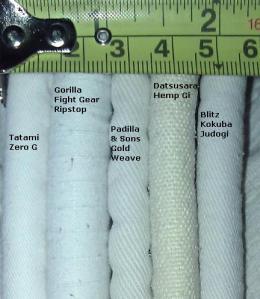 The trousers are secured with a bungee cord rather than the typical flat drawstring I’m used to. There are also five loops, meaning the rope is unlikely to move once you’ve tied it in place. I’ve read some reviews which say how ripstop trousers can become unpleasantly slimy and stick to the skin, but I haven’t found that with the Gorilla ripstop. They certainly feel different to typical heavy cotton trousers when they get drenched in sweat, but I didn’t notice any of the waxy stiffness some people have reported regarding other brands.
The trousers are secured with a bungee cord rather than the typical flat drawstring I’m used to. There are also five loops, meaning the rope is unlikely to move once you’ve tied it in place. I’ve read some reviews which say how ripstop trousers can become unpleasantly slimy and stick to the skin, but I haven’t found that with the Gorilla ripstop. They certainly feel different to typical heavy cotton trousers when they get drenched in sweat, but I didn’t notice any of the waxy stiffness some people have reported regarding other brands.
As with any ripstop, the material is much thinner than a standard gi: according to the website, it’s 250g/m ripstop fabric. That has the advantage of reduced weight and less sweat, but it does mean rather less padding for throws and the like (which I definitely noticed when I wore it at RGA Bucks, as the mats are much thinner and harder than those at GB Bristol). The jacket is made out of a single piece of cloth, so there aren’t any large seams on the back. There were a few loose threads, such as on the armpit reinforcement, but nothing major.
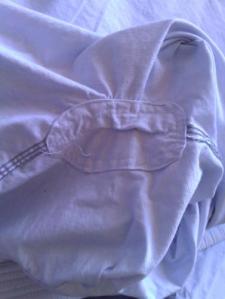 Rolling in the gi was comfortable, particularly during hot weather (which conveniently happened the first month I wore it, providing a good test). However, as with most ripstop gis, it is easier to grip. I also felt the collar digging into the back of my neck more than usual during one lesson, although that was probably more due to that particular training partner: I haven’t noticed it during other rolls. At one point a sparring partner went for about five cross-chokes in a row, so I think I can safely say it isn’t easier to get choked in this ripstop, or I would have been tapping. 😉
Rolling in the gi was comfortable, particularly during hot weather (which conveniently happened the first month I wore it, providing a good test). However, as with most ripstop gis, it is easier to grip. I also felt the collar digging into the back of my neck more than usual during one lesson, although that was probably more due to that particular training partner: I haven’t noticed it during other rolls. At one point a sparring partner went for about five cross-chokes in a row, so I think I can safely say it isn’t easier to get choked in this ripstop, or I would have been tapping. 😉
 I washed it at 40 degrees Celsius with a spin setting of 900, then hung the jacket and trousers on door hooks. Four hours later, it was mostly dry, getting completely dry two hours after that. This was in an unheated bathroom in the UK, which isn’t exactly known for its blazing temperatures. Either way, that means the gi would definitely dry overnight, so even if this was your only gi, you could easily wash and dry after training and still have a clean gi for the next day. I didn’t notice enormous shrinkage, as you can see from the pictures.
I washed it at 40 degrees Celsius with a spin setting of 900, then hung the jacket and trousers on door hooks. Four hours later, it was mostly dry, getting completely dry two hours after that. This was in an unheated bathroom in the UK, which isn’t exactly known for its blazing temperatures. Either way, that means the gi would definitely dry overnight, so even if this was your only gi, you could easily wash and dry after training and still have a clean gi for the next day. I didn’t notice enormous shrinkage, as you can see from the pictures.
 To work out how small this gi packs up, I pulled out a rucksack from the cupboard and laid out a bunch of shirts, a hoody, a book and a couple of DVD boxsets for bulk. I’m not quite sure what kind of awesome training trip would include watching the entirety of Mysterious Cities of Gold plus a season of Hercules, but hey: the Gorilla Ripstop left enough room for everything except the large book. By comparison, the Padilla & Sons single weave, which is a fairly typical size for a standard gi, couldn’t manage my belt or the DVDs. I rolled up each of the gis in the same way: the ripstop gi jacket effectively packs like a belt, as the fabric is thin enough to wrap tightly around it.
To work out how small this gi packs up, I pulled out a rucksack from the cupboard and laid out a bunch of shirts, a hoody, a book and a couple of DVD boxsets for bulk. I’m not quite sure what kind of awesome training trip would include watching the entirety of Mysterious Cities of Gold plus a season of Hercules, but hey: the Gorilla Ripstop left enough room for everything except the large book. By comparison, the Padilla & Sons single weave, which is a fairly typical size for a standard gi, couldn’t manage my belt or the DVDs. I rolled up each of the gis in the same way: the ripstop gi jacket effectively packs like a belt, as the fabric is thin enough to wrap tightly around it.
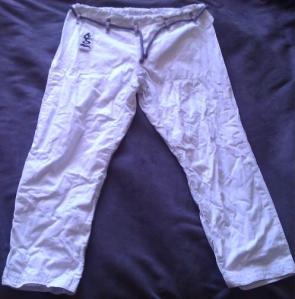 The ‘Hitman’ ripstop is relatively inexpensive, at $89 USD, especially as my sister’s mother-in-law kindly took delivery of the gi at her home in Vancouver, then brought it with her during a recent visit to the UK. You can also get them in black, for $10 USD extra. I thought it was in Canadian dollars when I looked a few months ago, but either they’ve changed it or I just misremembered.
The ‘Hitman’ ripstop is relatively inexpensive, at $89 USD, especially as my sister’s mother-in-law kindly took delivery of the gi at her home in Vancouver, then brought it with her during a recent visit to the UK. You can also get them in black, for $10 USD extra. I thought it was in Canadian dollars when I looked a few months ago, but either they’ve changed it or I just misremembered.
I should note that when I just checked, most of the smaller sizes were sold out (I bought this back in April, when only A1 was unavailable: clearly they’ve been selling well), so unless you’re a bigger grappler, you may need to wait for new stock. Mike provides good customer service, judging by the email he sent me, so worth checking with him if you’re uncertain about sizing.
Gi Review – Datsusara Hemp Gi (HCG-02)
Posted: 21/07/2011 Filed under: Datsusara, gi review, hemp, non-standard gi material, review 5 Comments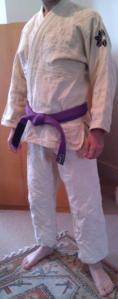 Short Review: According to Datsusara, their new gi benefits from the properties of hemp, which is allegedly anti-microbial, super strong, breathable and wears in with each wash rather than wears out. Of those, I can definitely confirm the last, as this is the most comfortable gi fabric I’ve ever worn. Another point in its favour, from my perspective, is the lack of bling.
Short Review: According to Datsusara, their new gi benefits from the properties of hemp, which is allegedly anti-microbial, super strong, breathable and wears in with each wash rather than wears out. Of those, I can definitely confirm the last, as this is the most comfortable gi fabric I’ve ever worn. Another point in its favour, from my perspective, is the lack of bling.
However, the unbleached colour and very baggy jacket may not appeal to everyone, though it does also come in black. There were also a lot of loose threads, which is a serious problem: Datsusara stated they are looking to rectify the issue. Presumably due to the difficulties of manufacturing hemp, the gi isn’t cheap, at $140. Available to buy here.
 Full Review: Thanks to Seymour at Meerkatsu, a Datsusara hemp gi arrived at my house a couple of weeks ago. Meerkatsu is the place to go for gi reviews, but results in Seymour being incredibly busy: hence why he passed this one along to me. I also get to benefit from his photography skills, which is awesome. That means that rather than solely relying on my camera phone, I can put up some professional snaps (as always, click on the picture for the full size image).
Full Review: Thanks to Seymour at Meerkatsu, a Datsusara hemp gi arrived at my house a couple of weeks ago. Meerkatsu is the place to go for gi reviews, but results in Seymour being incredibly busy: hence why he passed this one along to me. I also get to benefit from his photography skills, which is awesome. That means that rather than solely relying on my camera phone, I can put up some professional snaps (as always, click on the picture for the full size image).
As I’ve written numerous times in the past, I like my gis to be as plain as possible. On that score, Datsusara delivers: there is an embroidered logo on the back and the arm, along with a small patch on the trousers, but that is it. In my opinion, the logo – representing hemp – is also quite appealing, in an unobtrusive Japanese mon style, with no written text (something I find off-putting about many other gis). The back logo could possibly be placed higher, for those of you who want to add a team patch, but as I never add patches it wasn’t a concern in my case.
 In addition, this is without any doubt the most comfortable gi material I’ve ever worn. When I first tried on the jacket, it felt like a high quality dressing gown. The cut feels comparable to my judogi, in that it is loose and baggy with wide sleeves. Seymour told me that it used to be even larger, but there was a lot of shrinkage after he washed it twice (at 60 and 40 degrees Celsius respectively). I would advise that if you like a tighter fit, it would be sensible to go for the size below your normal gi. I haven’t yet tried throwing it in the tumble drier for further shrinkage, but may give that a go during my next visit to my parents.
In addition, this is without any doubt the most comfortable gi material I’ve ever worn. When I first tried on the jacket, it felt like a high quality dressing gown. The cut feels comparable to my judogi, in that it is loose and baggy with wide sleeves. Seymour told me that it used to be even larger, but there was a lot of shrinkage after he washed it twice (at 60 and 40 degrees Celsius respectively). I would advise that if you like a tighter fit, it would be sensible to go for the size below your normal gi. I haven’t yet tried throwing it in the tumble drier for further shrinkage, but may give that a go during my next visit to my parents.
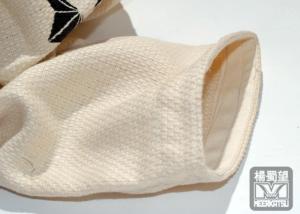 When I first wore the gi, that bagginess was noticeable during shrimping, as the collar bunched up uncomfortably behind my neck. However, that problem seems to have disappeared by the time I wore it for a sparring class. Either I’ve gotten used it, or it has shrunk a little after I washed it (on the quick thirty minute setting). In the accompanying letter Datsusara sent Seymour with the gi, it says that it will shrink up to 5% in the wash (something of an understatement, judging by Seymour’s stats, which I’ve included towards the bottom of the review). It also recommended washing it at least twice: at the time of writing, it’s been washed three times.
When I first wore the gi, that bagginess was noticeable during shrimping, as the collar bunched up uncomfortably behind my neck. However, that problem seems to have disappeared by the time I wore it for a sparring class. Either I’ve gotten used it, or it has shrunk a little after I washed it (on the quick thirty minute setting). In the accompanying letter Datsusara sent Seymour with the gi, it says that it will shrink up to 5% in the wash (something of an understatement, judging by Seymour’s stats, which I’ve included towards the bottom of the review). It also recommended washing it at least twice: at the time of writing, it’s been washed three times.
 A more serious issue is the stitching. I was surprised by how many loose threads there were, to the extent that the trousers look as if they’ve been ripped in several places after years of training, when in fact they’re brand new. It isn’t difficult to remedy, as I sewed up the four most noticeable areas, but this definitely needs to be sorted out for the next batch. Although I should note that in that letter, they do acknowledge the problem. To quote: “If you find loose threads please simply cut or cut and burn the ends, we apologize for the sloppy stitching but we are working on it.”
A more serious issue is the stitching. I was surprised by how many loose threads there were, to the extent that the trousers look as if they’ve been ripped in several places after years of training, when in fact they’re brand new. It isn’t difficult to remedy, as I sewed up the four most noticeable areas, but this definitely needs to be sorted out for the next batch. Although I should note that in that letter, they do acknowledge the problem. To quote: “If you find loose threads please simply cut or cut and burn the ends, we apologize for the sloppy stitching but we are working on it.”
 The natural unbleached colour takes a bit of getting used to, but it is relatively unassuming. The only reaction I got was that one training partner asked if it was an old gi which had faded from heavy use. My girlfriend, on the other hand, said it looked like the gi had been drenched in tea. I’ve heard that unbleached used to be quite common back in the day, the most famous probably being the HCK unbleached single. It has fallen out of favour more recently, but perhaps Datsusara will be part of a general return to that classic look. I prefer white, but then the lack of bleaching does make for a stronger fabric. Given that considerable advantage, I’m sure I could get used to it.
The natural unbleached colour takes a bit of getting used to, but it is relatively unassuming. The only reaction I got was that one training partner asked if it was an old gi which had faded from heavy use. My girlfriend, on the other hand, said it looked like the gi had been drenched in tea. I’ve heard that unbleached used to be quite common back in the day, the most famous probably being the HCK unbleached single. It has fallen out of favour more recently, but perhaps Datsusara will be part of a general return to that classic look. I prefer white, but then the lack of bleaching does make for a stronger fabric. Given that considerable advantage, I’m sure I could get used to it.
 Feedback elsewhere on the internet has been largely positive, such as on The Underground and Georgette’s thorough review (she mentions she wore the gi to sixty classes at the time of writing). Over on Sherdog, company head Chris Odell actively engages with customers. He also directly adresses their concerns, such as this response on the widespread stitching deficiencies:
Feedback elsewhere on the internet has been largely positive, such as on The Underground and Georgette’s thorough review (she mentions she wore the gi to sixty classes at the time of writing). Over on Sherdog, company head Chris Odell actively engages with customers. He also directly adresses their concerns, such as this response on the widespread stitching deficiencies:
“Sorry again for the loose threads on some gis. I talked to my manufacturer and they said they had rushed many of the units to make our deadline, hence were sloppy on a few. I am taking steps to make sure that doesn’t happen again: if anyone has threads that cause the gi to lose structural integrity we’ll fix it for you, just email us.”
In terms of the lint problem noted by wearers of the black edition, Odell responded that “from what I have gathered, that stops after two cold water washes and low heat drying,” which is supported by the experiences others relate in the same thread. It doesn’t appear to be a problem with the unbleached version.
 The unique selling point of the gi is that it is made entirely out of hemp, rather than the usual cotton. Datsusara are the first company to successfully market and sell a hundred percent hemp gi. Other companies have tried, but have either got stuck in the marketing phase waiting to get production off the ground (like The Green Gi), or sold a product but then folded (like EnviroGi). Datsusara have been selling various equipment made of hemp for some time now: perhaps unsurprisingly, the website makes a lot of claims regarding the benefits of hemp. Some of them I can easily confirm, such as that the material is light and comfortable. Others require a bit more research: I’m not a scientist, but I can at least have a look at what sources are available on the internet.
The unique selling point of the gi is that it is made entirely out of hemp, rather than the usual cotton. Datsusara are the first company to successfully market and sell a hundred percent hemp gi. Other companies have tried, but have either got stuck in the marketing phase waiting to get production off the ground (like The Green Gi), or sold a product but then folded (like EnviroGi). Datsusara have been selling various equipment made of hemp for some time now: perhaps unsurprisingly, the website makes a lot of claims regarding the benefits of hemp. Some of them I can easily confirm, such as that the material is light and comfortable. Others require a bit more research: I’m not a scientist, but I can at least have a look at what sources are available on the internet.
In the ‘why hemp’ section of the official website, it says hemp is four times stronger than cotton, anti-microbial (bacteria, mold and fungus supposedly can’t live in it), green (readily renewable, uses limited water during the cultivation process) and porous (meaning it breathes well and dries more quickly: mine took around a day to dry fully). The website also states that the fabric will wear in rather than out, increasing in comfort while retaining strength with each wash.
 The first thing you’ll most likely hear when you mention you’re wearing a hemp gi is a tongue-in-cheek “can you smoke it?” I’ve never looked into the issue much until now, but according to Dr David P. West (admittedly a biased source, as his article was produced for the North American Industrial Hemp Council), hemp and marijuana are quite different. Marijuana is high in the psychoactive ingredient delta 9-tetrahydro-cannabinol (THC), while industrial hemp is not: it is theoretically possible to distill THC from hemp, but it would be a very expensive and time-consuming process. He also runs through the various advantages of hemp, which ties in with Datsusara’s claims.
The first thing you’ll most likely hear when you mention you’re wearing a hemp gi is a tongue-in-cheek “can you smoke it?” I’ve never looked into the issue much until now, but according to Dr David P. West (admittedly a biased source, as his article was produced for the North American Industrial Hemp Council), hemp and marijuana are quite different. Marijuana is high in the psychoactive ingredient delta 9-tetrahydro-cannabinol (THC), while industrial hemp is not: it is theoretically possible to distill THC from hemp, but it would be a very expensive and time-consuming process. He also runs through the various advantages of hemp, which ties in with Datsusara’s claims.
 The position laid out by West is corroborated by this 2001 piece in The Guardian, by Dr Claire Cockcroft from the Institute of Biotechnology in Cambridge. Here is another piece, although again from over a decade ago, which looks fairly objective.
The position laid out by West is corroborated by this 2001 piece in The Guardian, by Dr Claire Cockcroft from the Institute of Biotechnology in Cambridge. Here is another piece, although again from over a decade ago, which looks fairly objective.
To finish with some gi statistics, 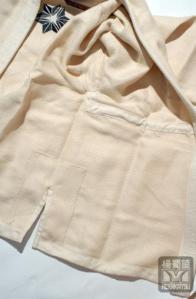 The jacket is a one piece construction, made from a 17oz (580gsm) long fiber weave. According to the shrinkage numbers Seymour emailed, the width across the sleeves (‘A’ in Seymour’s handy gi diagram) shrunk from 165cm to 153cm, after a wash at sixty and then forty degrees Celsius. The length from the shoulder to the bottom of the jacket (‘B’ on the diagram) began at 80cm, then dropped down to 74cm after the washes. The width across the bottom of the jacket (‘C’) was 63cm out of the box, going down to 56cm after washing. Seymour noted that during his tests, the jacket weighed 1.36kg.
The jacket is a one piece construction, made from a 17oz (580gsm) long fiber weave. According to the shrinkage numbers Seymour emailed, the width across the sleeves (‘A’ in Seymour’s handy gi diagram) shrunk from 165cm to 153cm, after a wash at sixty and then forty degrees Celsius. The length from the shoulder to the bottom of the jacket (‘B’ on the diagram) began at 80cm, then dropped down to 74cm after the washes. The width across the bottom of the jacket (‘C’) was 63cm out of the box, going down to 56cm after washing. Seymour noted that during his tests, the jacket weighed 1.36kg.
 Similarly, the trousers are made from 11oz (370gsm) long fiber weave. There is the option of either the default flat drawstring, or a thicker rope version, included separately with gi. Shrinkage on the length of the leg (‘E’ on Seymour’s diagram) was from 104cm to 93cm, while the width of the trousers legs (‘F) went from 55cm to 52cm. The bottom of the leg width started at 25cm and went down to 24cm, then finally measurement ‘H’ shrunk from 43cm to 39cm. Seymour stated that when he weighed the trousers, they came out at 0.66kg.
Similarly, the trousers are made from 11oz (370gsm) long fiber weave. There is the option of either the default flat drawstring, or a thicker rope version, included separately with gi. Shrinkage on the length of the leg (‘E’ on Seymour’s diagram) was from 104cm to 93cm, while the width of the trousers legs (‘F) went from 55cm to 52cm. The bottom of the leg width started at 25cm and went down to 24cm, then finally measurement ‘H’ shrunk from 43cm to 39cm. Seymour stated that when he weighed the trousers, they came out at 0.66kg.
The $140 price tag on the site is more than I would normally pay for a gi. It is also set to rise in the next batch, from what I’ve read. Then again, should hemp live up to the strength and durability touted on the website, that may well prove to be a good investment. If Datsusara can solve the stitching problem, this could become a serious competitor on the gi market. It will be interesting to see what happens with the next batch. Available to buy here.
I’ll close with a video of the company owner providing his thoughts on the gi, which are obviously going to be biased, but nevertheless gives you a look at the black version of the HCG-02:
Update Dec 2012: My review of the HCG-03 is now up, here.
